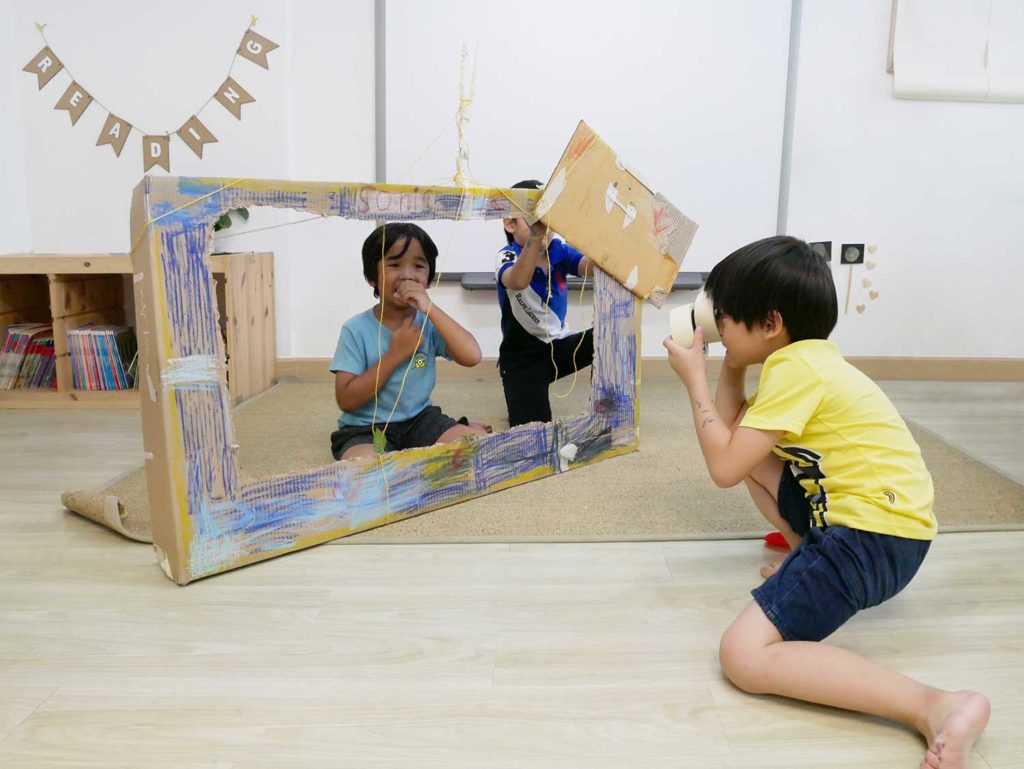Reggio Emilia – The Principles of the Reggio Emilia Approach

This post attempts to introduce and give an overview of the guiding principles and beliefs of the Reggio Emilia Approach.
The Hundred Languages of Children
The approach emphasizes the importance of children’s symbolic language. The hundred “languages” are the many modes of expression, such as speech, writing, movement, drawing, painting, sculpture, shadow play, collage and music, through which children communicate and learn about their world.
Various media, when combined to tell a story, form the 100 languages. Teachers learn to listen to the “100 Languages” that children use to express themselves as individual learners and as “teachers” in their own right.
The Role of the Environment
Through conscious use of space, colour, natural light, displays of children’s work, and attention to nature and detail, the environment serves as another teacher.
Commitment and creativity of teachers and parents are reflected in the attention to detail and design. Intrigue and curiosity result from careful placement of materials and products of children from previous years. Adults and children personalize each school with their message boxes, art, documentation panels and investigations.
Colour, light, mirrors, shadows, recyclable materials and natural artefacts including plants are used to enhance the environment and provide discovery opportunities. The layout of physical space, in addition to welcoming whoever enters the school.
“children learn more effectively” when they are able to use a wide variety of materials in a wide range of activities and in cooperation with adults who help them ask good questions. In addition, it is desirable to provide environmental support that is a real collaboration among school, families and the community.
The Role of the Teacher
Teachers mediate between children’s current understanding and what they are on the threshold of understanding by:
-reviewing and helping children tell the story of their own learning;
-arranging new experiences, challenges and problems;
-connecting children with resources;
-facilitating group discussions and social interactions;
-reflecting children’s ideas; and
-facilitating the development of new skills.
To know how to plan or proceed with the children’s learning, teachers observe and listen to them closely. Teachers use the understanding they gain in this way to act as a resource for them. They ask questions and discover the children’s ideas, hypotheses and theories.
Then the adults discuss together what they have recorded through their own notes, or audio or visual recordings, and make flexible plans and preparations. Then they are ready to enter again into dialogues with the children and offer them occasions for discovering and also revisiting experiences since they consider themselves to be partners in this process of learning which might proceed with pauses and setbacks, but which is an experience constructed and enjoyed together with the children.
The Importance of Time
Investigations and activities are not “one-shot deals”; rather they build upon one another over time, as experiences, activities and forms of expression.
Children know that their “work” will remain intact and in place until they have completed their task. Children have the time and guidance to use the same materials repeatedly until they are pleased with the results.
Children’s own sense of time and their personal rhythm are considered in planning and carrying out activities and investigations. Teachers get to know the personal time of the children and each child’s particular characteristics.
The Value of Relationships and Interaction of Children in Small Groups
In preparing the space, teachers offer the possibility for children to be with the teachers and many of the other children, or with just a few of them, or even alone when they need a little niche to stay by themselves.
However, teachers are always aware that children learn a great deal in exchanges with their peers, especially when they can interact in small groups. Such small groups of two, three, four or five children provide possibilities for paying attention, hearing and listening to each other, developing curiosity and interest, asking questions, and responding to them.
This type of small group also favours the emergence of cognitive conflicts that can initiate a process in which children construct together new learning and development.
Observation and Documentation
As the teacher’s role becomes more of an observer and documenter, she becomes a facilitator and co-learner.
The way the Reggio teachers facilitate the learning is by asking questions that lead children to other thoughts and further actions. The teacher also provides books and other resources on investigation topics that children examine in order to make relevant decisions.
The teachers explain that they learn how to work with children by continuously observing.
The teachers do not rely solely on their memory but document interactions and learning by audio or visual taking, writing notes and taking slides or photographs of the children. Transcripts of children’s remarks and discussions, photographs of their activity, and representations of their thinking and learning using many media are carefully arranged by teachers, to document the children’s learning (and the process of learning) done in schools.
The Curriculum
“the potential of children is stunted when the endpoint of their learning is formulated in advance” (Carlina Rinaldi), teachers develop an “emergent curriculum” in collaboration with the learners.
The Reggio Emilia curriculum is not established in advance.
Teachers express general goals and make hypotheses about what direction activities and investigations might take; consequently, they make appropriate preparations.
Then, after observing children in action, they compare, discuss and interpret together their observations and make choices that they share with the children about what to offer and how to sustain the children in their exploration and learning.
Children pursue extensive investigations of their world, guided by teachers who share their sense of adventure and “amazement”.
Investigations
Investigations provide the backbone of the children’s and teacher’s learning experiences. They are based on the strong convictions that learning by doing is of great importance and that to discuss in groups and to revisit ideas and experiences is the primary way of gaining better understanding and learning.
Ideas from investigations originate in the continuum of the experience of children and teachers as they construct knowledge together. Investigations can last from a few days to several months.
They may start either from a chance event, an idea or problem posed by one or more children, or an experience initiated directly by the teachers.
Investigations can be based on any relevant topic such as shadows, reflections, dinosaurs or rain in the city. Their distinguishing aspects included the following:
1.The teacher’s role is that of both facilitator and partner in learning;
2.Topic selection is based on student interests and experiences;
3.Collaboration occurs among students, teachers and parents;
4.Investigation content emerges from students’ spiralling understanding;
5.Multiple experiences occur with the same and different media in order to represent cognition;
Repetition of activities takes place for different purposes;
Extended time may be devoted to an investigation;
Investigations are usually small-group rather than whole-class;
An investigation should include a broad range of concepts, such as maths, science, art, writing, social studies and music.
Planning Process:
Once the topic has been chosen
Give the children a selection of books
Listen to and record questions and interest and quotes from children.
Pool together and share everyone’s knowledge
What to we want to find out?
How can we find that out?
